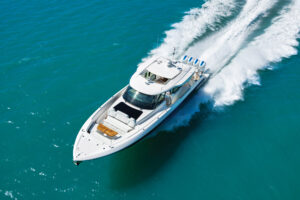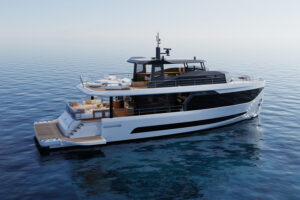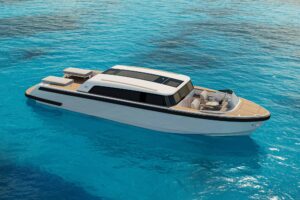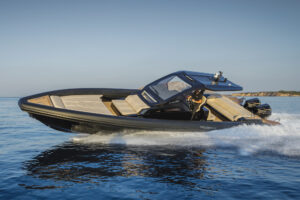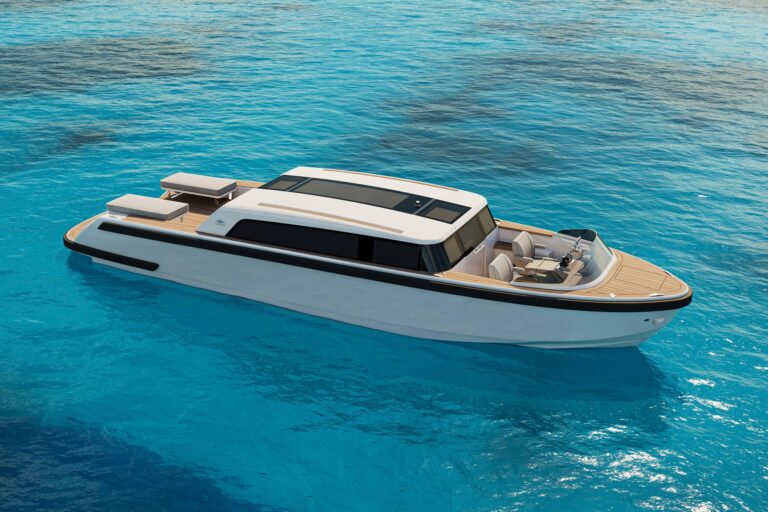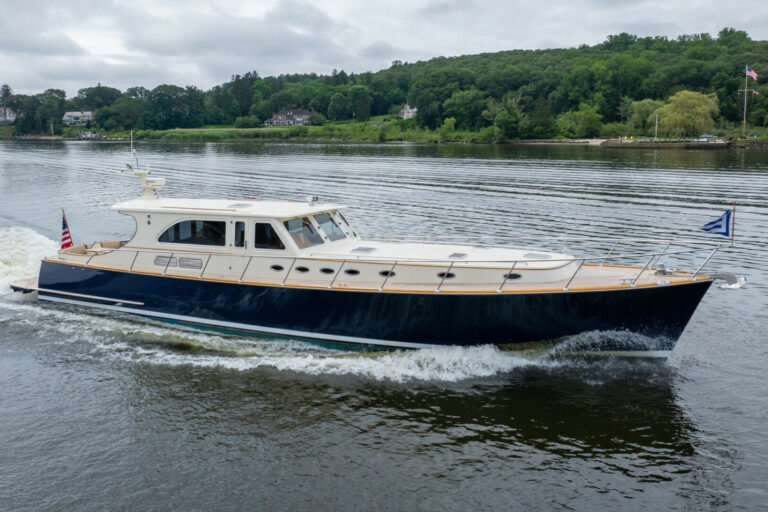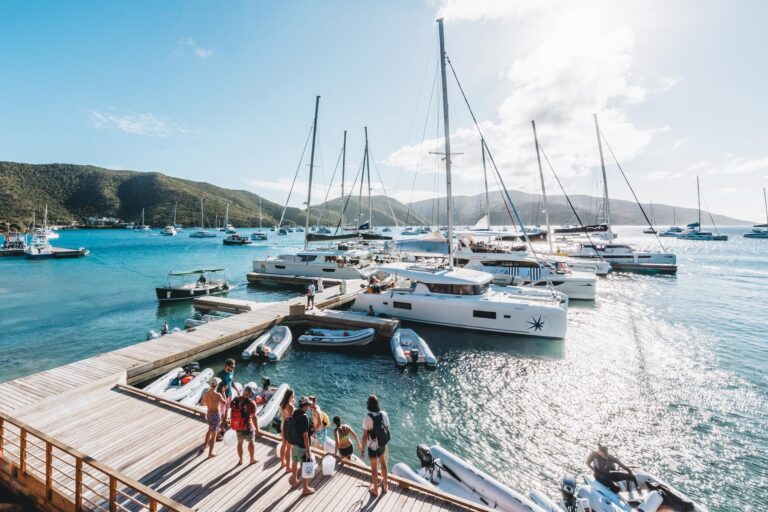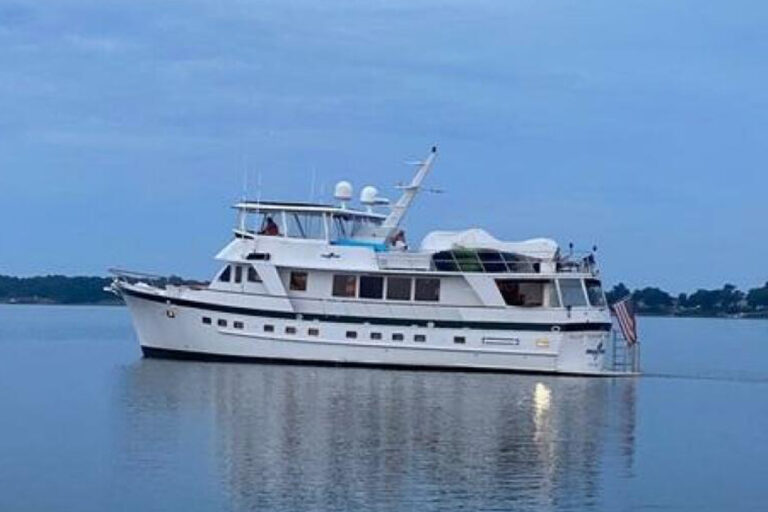When I spoke with San Juan Composites founders Donald Campbell and Randy Purdy via cell phone, they were in a post-Hurricane Isabel mess, making their way west at 25 knots through Long Island Sound aboard the company’s first 48-footer. The 20-knot northeast following wind and outgoing current against them created some real slop.
It didn’t stop the San Juan 48 from gliding into Port Washington Harbor, New York, a few hours after our phone call. Standing on the dock, I thought the trip had got the better of Purdy, who was at the helm attempting a downwind approach. But I’ll be darned-as if on rails the express, with the aid of her standard bow- and sternthrusters, tracked sideways and gently nuzzled up to the floating dock. She was a little salty, perhaps, but none the worse for wear.
“This boat is a product of listening to the market as well as listening to our employees on the floor”, Campbell later said while sipping a cup of Dunkin’ Donuts’ finest. “It was designed on three fundamental principles: performance, looks and standard of finish.”
Indeed, the San Juan 48 is a special, well-constructed package that takes advantage of the latest technology. She is finely crafted to exacting standards with many innovative features, top-of-line components and a price tag to match. The casual boater may scoff at her, but those in the know, especially those stepping up from her sibling, the San Juan 38, have supported the builder’s creation.
Most everything one could want is standard on this yacht; a complete San Juan 48 can be delivered at $1.5 million. Not surprisingly, things add up when the goal is to build an express cruiser like few others-it’s blank-check boating, if you will. As a result, the Burmese teak, for example, gets 12 coats of West System urethane. The design team has incorporated waterways that channel moisture around the muscular hardware. Almost every hardware item is recessed, and all corners are radius.
The brochure lists every feature, but worthy of note are the trash compactor, dishwasher, washer/dryer, dual flat-screen televisions, windlass with remote, 3,000-watt inverter, custom soundproofing and 600-gallon-per-day watermaker. All components are from top-flight manufacturers.
The 48’s hull has a fine, deep entry forward and an exaggerated flare with progressive flam that smoothes entry and knocks down spray. A subtle tumblehome is aft, with a molded-in swim platform that requires an intermediary step from the cockpit. A standard 91/2-foot tender stows in a transom compartment, leaving the platform functional, and the cleats hide away. Smartly placed steps access wide side decks.
Lifting strakes are part of the design below, and the custom, variable-pitch four-blade Nibrals sit within pockets. Her solid performance and shallow draft (less than 3 feet) can be attributed to this feature. Though jet drives were explored, the builder chose a V-drive system, deeming it a better seakeeping match for this hull. I like the selection.
San Juan Composites uses Kevlar/E-glass and a Core-Cell foam core vacuum-infused with epoxy vinylester resin. The hull is finished with custom Sterling LP paint in the owner’s choice of color. Any hull penetration is surrounded by solid fiberglass. The fairing of the hull sides reflects some of the man-hours poured into the product; they are mirror-like.
Engine access is through the hydraulic day hatch or via the cockpit engine boxes. The strategic placement of the engines contributes mightily to the feng shui of the yacht by allowing for what I believe is an even social flow, stem to stern (though the engine boxes do steal from the cockpit area). The 825 hp Series 60 Detroit Diesels are isolation-mounted under cockpit boxes that provide seating or sunning opportunities. The shielded 12kW Northern Lights genset is similarly mounted. A turbo condensation basin below the engines keeps moisture out of the bilges. All surfaces are finished and insulated where possible, six batteries have dedicated wells, and wiring and plumbing runs are of expected quality. An oil-transfer pump is standard. Aqualift custom-designed the exhaust system.
“Owners will spend only about 15 percent of their time aboard in their cabin”, Campbell said. So it makes perfect sense that the pilothouse area garnered serious consideration from the builder.
The teak sole is level from the transom forward to the house bulkhead. Above the after bulkhead are clear panels that may be removed. When the hydraulically controlled sunroof is retracted, you have open-air cruising at its best. Inside the house is impressive headroom-more than 7 feet-and it is nearly that below. A tidy day service area is to starboard with a sink, an icemaker, a refrigerator and stowage.
A semicircular settee with a table is to port, close enough to the helm for conversation and for charts. The double helm seat is low for my stature but works well for the tall Purdy. A future San Juan 48 owner has special physical needs, and they will be gladly met-the benefits of going custom, Purdy said.
I felt bad about putting the guys through a test after their long run, but they were enthusiastic. The helm area easily accepts the standard electronics package, which includes a Simrad autopilot, a Furuno NavNet combination unit and a Standard VHF.
As we cruised at 27 knots into the abrupt and tightly stacked 3-footers, I lowered the bow with the aid of the trim tabs, and she responded well, minimizing the pound. The diesels were under a 65 percent load at 1650 rpm. Pulling off the throttles ever so slightly created a comfortably smooth ride. San Juan reports a range of 500 miles at 25 knots; note her substantial 750 gallons of fuel. At a mere 1200 rpm the boat was on plane, skipping along at 17 knots.
My hard turns, according to Purdy, did not accurately exploit her abilities. I willingly relinquished the helm to let the builder carve a punishing hard-over turn at 34 knots, where she proved that if an errant craft popped up suddenly in front of her, she would have all the right moves. During the turn the sunroof provided visibility to the turning side when the top, as is often the case, blocked the view. She turns in her length and backs down true. An extended brow from the top helps reduce glare for the skipper.
Top speed that day was 37.1 knots. The builder reports 40, and I believe that is accurate given the amount of owner’s gear and boat show regalia she was carrying.
When it is time to retire or work some galley magic, the facilities are beyond weekend-capable. The forward master cabin has fine teak joinery with a satin finish, solid framed doors, bookshelves, under-berth stowage and beautiful trim work that ties in the décor. One of the two chilled-water air conditioning units-a total 44,000 BTUs-is dedicated to this space. There is a hot-water circulating pump, so sinks and showers in both heads have instant hot water. Also, a porthole ventilates each, and both MSDs direct-drop to the black-water tank.
A convertible area is opposite the galley on the starboard side and may be used as a settee or expanded to a queen berth with a pipe berth above for additional sleeping capacity. A pocket door isolates the space. From my many occasions on board, I came away with two minor observations relating to the door. First, the door tracks are hard on bare feet. Also, when the door is closed, I question whether its louvers will allow enough cool air into the stateroom, which has no duct. Purdy assured me unequivocally that my concern is not an issue; the cabin will be sufficiently cool.
The portside galley is open above, right to the pilothouse ceiling, making interaction with guests and crew possible virtually everywhere on board. A full-size fridge and complement of appliances more than adequately outfit the area. The washer/dryer is under the hinged steps to the pilothouse.
In the highly specialized market of lobster-style yachts, the emphasis is ultimately on quality and design. San Juan Composites started with a blank sheet and was not afraid to produce a build whose workmanship and standard equipment put an upper-echelon price on the finished product. If this is your pleasure, the San Juan 48 delivers.
Contact: San Juan Composites, (360) 299-3790; www.sanjuan48.com. For more information, contact: (866) 922-4877; www.yachtingnet.com/yachting/productinfo.

